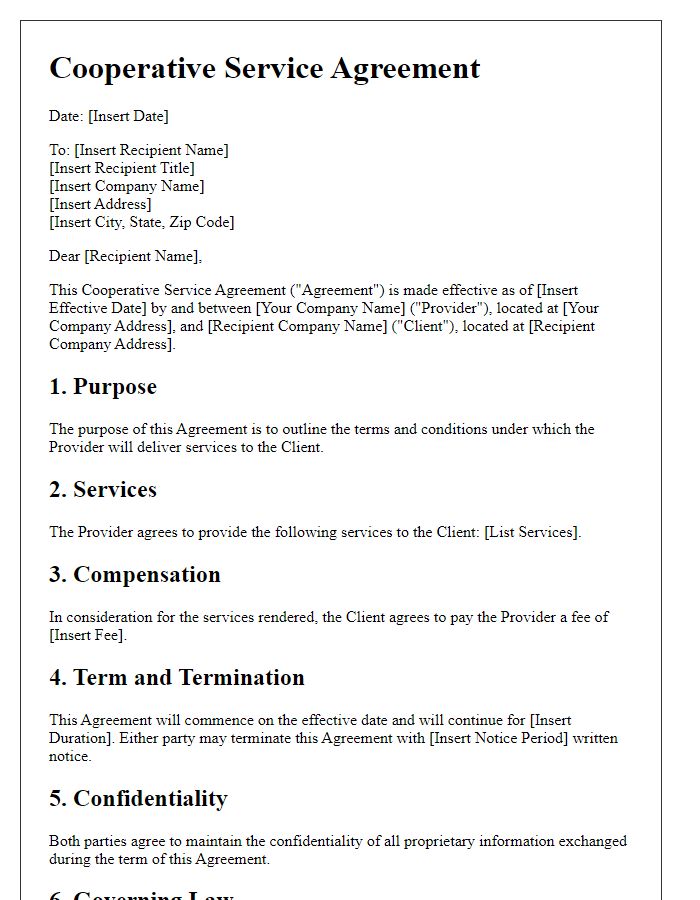Are you looking to establish a solid foundation for a partnership? Crafting a service partnership agreement can be crucial for ensuring clear communication and mutual benefit. This type of agreement lays out the roles and responsibilities of each party while defining expectations for service delivery. Intrigued to learn how to create a compelling partnership letter? Read on to explore essential tips and a helpful template!

Mutual Objectives and Goals
A service partnership agreement outlines mutual objectives and goals between two entities collaborating for shared success. Objectives may include increasing market reach by 30% within the next fiscal year or enhancing customer satisfaction ratings to above 90% within specific service sectors. Common goals can encompass streamlining operational processes to reduce costs by 15% through efficient resource allocation or implementing joint marketing campaigns aimed at boosting brand visibility in key demographics such as millennials and Gen Z. Additionally, establishing regular communication checkpoints, such as quarterly review meetings, can ensure alignment and adaptability in strategies, fostering a productive partnership that encourages growth and innovation in competitive landscapes.
Scope of Services
The Scope of Services for a service partnership agreement outlines the specific tasks and responsibilities to be undertaken by each party involved in the collaboration. This scope might include tailored solutions such as consultation services, project management, or technical support based on client needs. For instance, a technology partnership may define software development milestones, quality assurance processes, and deployment timelines. Important parameters like service level agreements (SLAs) may dictate response times for customer support queries, ensuring that issues are addressed within a 24-hour framework. Additionally, metrics such as key performance indicators (KPIs) could be established to evaluate the effectiveness of the partnership over time, ensuring accountability and alignment with mutual goals. Regular review meetings might be scheduled quarterly to assess progress and adapt services as necessary, fostering a dynamic and responsive relationship between partners.
Terms and Termination
The 'Terms and Termination' section of a service partnership agreement outlines the specific conditions under which the partnership operates and the manner in which it can be dissolved. The agreement typically stipulates a duration (commonly one year), during which the parties will collaborate on various service initiatives. Termination clauses often provide options for either party to terminate the agreement with a notice period (ranging from 30 to 90 days), allowing for a smooth conclusion of the partnership. Conditions for immediate termination may include breaches of contract, unethical conduct, or legal violations. This section is vital for defining responsibilities and liabilities during the partnership and ensuring a clear process in the event of separation, enabling both parties to protect their interests effectively.
Confidentiality and Data Protection
Confidentiality and data protection are critical components in service partnership agreements between entities, such as businesses or organizations. This agreement outlines the measures taken to ensure that sensitive information shared by both parties, including operational data, proprietary information, and personal data of clients or employees, remains confidential. Key aspects include compliance with data protection regulations, such as the General Data Protection Regulation (GDPR) in Europe, which mandates strict guidelines for handling personal data. Both parties must implement technical safeguards, such as encryption and secure access control, to protect data against unauthorized access. Additionally, regular training sessions for employees regarding data protection practices and confidentiality obligations are essential to minimize the risk of data breaches. Detailed provisions for the return or destruction of data upon termination of the partnership should also be included to ensure protection of confidential information.
Dispute Resolution and Governing Law
Dispute resolution mechanisms play a vital role in service partnership agreements, ensuring that conflicts are addressed effectively. Mediation, a preferred first step, allows parties to resolve disputes amicably with the help of a neutral third-party mediator, which can reduce costs and preserve relationships. If mediation fails, arbitration may take place, where an arbitrator provides a binding resolution outside of court. Jurisdiction typically falls under specific governing laws, providing a legal framework for the agreement; for instance, contracts often specify the state of New York or California. Each party must ensure compliance with local regulations and dispute resolution procedures outlined in the partnership agreement to maintain clarity and enforceability.













Comments